

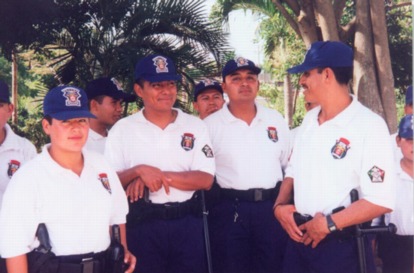 There's lots that's new in Puerto Escondido in this brand new year. Most noticeable are the smart
young recruits of the new State Tourist Police.
There's lots that's new in Puerto Escondido in this brand new year. Most noticeable are the smart
young recruits of the new State Tourist Police.
Well-equipped and specially trained to provide additional assistance and protection for our visitors, Puerto's 16-member corps, under the command of Cdte. José Antonio Martínez, is one of three contingents just commissioned for the high tourist season. (The others are in Huatulco and the city of Oaxaca.)
There's also a brand new market in town. Many years in the making, the new structure now comfortably houses most of the vendors who were crowded into the old building and spilling into the streets surrounding it.
If you've been looking for your favorite juice bar, fish vendor or vegetable lady, consult this month's guide to the new Benito Juárez market.
Have a Happy and Healthy 2002
- - Warren Sharpe, editor El Sol de la Costa
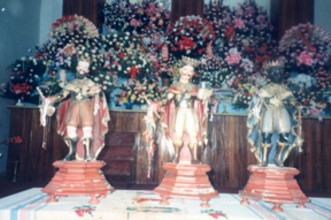 Wed 2 - Tue 8
Wed 2 - Tue 8
Fiesta of the Holy Kings
The three kings, Gaspar, Melchior and Balthazar, are the patron saints of this Chatino hill town
about an hour and half from Puerto. This is their annual fair with a huge market, and all the other
trappings of a traditional fiesta: processions, fireworks, dances, sports events and rodeos. A
full schedule of events was unavailable at this writing but the highlights will include:
Sat 5
Folkloric Dancing, including the famous Chatino Dance of the Turkey
Castillo, the spectacular traditional fireworks display
Dance with Live Band,
Sun 6, Mon 7
Jaripeo,
the bull-riding rodeo events so popular in the region.
Sun 6, Tue 8
Convivio
All are invited to feast at the homes of the mayor-domos, or sponsors, who gain enormous
prestige by hosting the fiesta.
Tue 8
Dance with Live Band,
Santos Reyes Nopala
(See below for more.)
Sun 6
Day of the Kings
The final day of Christmas is the traditional day for gift giving in
México. So if you just arrived, it s not too late to bring a gleam to
some kid s eye. There is likely to be some program for children at the
Town Hall Plaza in the late evening.
Sun 13
New Moon in Capricorn at 7:29 a.m.
Mon 14 - Thu 17
Fiesta of the Virgin of the Poor
Colonia Lázaro Cárdenas, Puerto's oldest and most populous neighborhood is located
beside the army base across the highway from Zicatela Beach.
It is a modest community of fishermen and working people whose patron saint is honored in this annual fair.
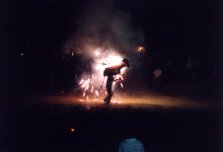 At the start of the festivities, a small carnival sets up offering rides, sideshows and shooting
galleries. There will booths selling full meals, snacks, sweets and beverages. Nightly cockfights
are also a fiesta staple.
At the start of the festivities, a small carnival sets up offering rides, sideshows and shooting
galleries. There will booths selling full meals, snacks, sweets and beverages. Nightly cockfights
are also a fiesta staple.
The major night is the saint's day eve, vispera, in this case Tue 15. This the night of the castillo, the amazing fireworks display built around a cane and bamboo tower, preceded by the anarchic running of the
Toritos (little bulls), models rigged with fireworks and crackers carried by young men who race around the square in a haze of light and explosion.
There will also be dances, sports contests, horse races, the traditional convite and calenda processions as well the usual religious rites. Col. Lázaro Cárdenas
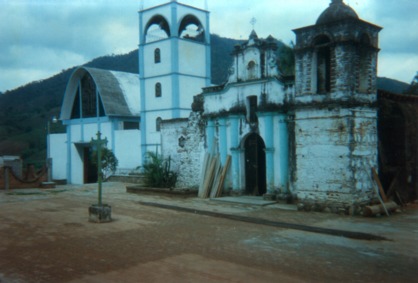 Fri 18 - Mon 21
Fri 18 - Mon 21
Annual Fiesta San Juan
Lachao Pueblo Nuevo
If you didn't get up to visit the Chatino hill country during the Day of Kings celebrations,
here's another reason. A full complement of events is slated for the annual fair in this town near
Santos Reyes Nopala.
Mon 28
Full Moon in Leo at 5:50 p.m
February Alert
Superbowl Sunday
Most bars and restaurants will be able to get the contest in Spanish on TV Azteca. If you want
to watch with English commentary, and see those great ads, try the Superbowl Party at Art & Harry's
Bar & Grill on Zicatela.
Sunday Feb. 3
Live Music Blues from Canada
The local nightlife scene received a shot in the arm last year with the visit of Jack de Keyzer,
generally acknowledged to be Canada's premier blues musician. This month the Split Coconut brings
de Keyzer back to Puerto, with the Peter Sabourin, for a four night gig. But that's not all; one
week later there will be more Canadian blues with Chris Chown, Don't miss it.
Jack de Keyser & Peter Sabourin
Fri 4
Tequila Sunrise Disco, Av. Marina Nacional
Sat 5, Mon 7, Wed 9
The Split Coconut, opposite Hotel Santa Fe
Chris Chown
Fri 11, Sat 12, Mon 14, Wed 16
The Split Coconut
Radio, Radio
Sunday 8 p.m. to 10 p.m.
Chiles y Chocolates, a bilingual radio
program hosted by "Lucy Sonido", actually Canadian musicologist Helena Szutska, an eclectic mix of
music from around the world.
Wednesday 9 p.m.
La Luciernaga (Firefly)
Lucy's midweek, commercial-free hour of free-flowing music. Radio Esmeralda,
94.1 FM.

Just 15 minutes from town is Manialtepec Lagoon, a river-fed, mangrove-surrounded lake that is typical of the topography along the Oaxacan coast. These mangrove wetlands are one of the richest sources of biodiversity in the world.
An hour away is Chacahua Lagoon National Park, an even more extensive stretch of wetlands, where, like Manialtepec, launch tours explore the wealth of bird and other wildlife and how all these elements sustain a unified ecosystem.
Heading south towards Huatulco, you can explore the tide pools at Agua Blanca or visit the Iguana Hatchery perched below the bridge over the Cotzoaltepec River. On the road to Mazunte, home of the famous Mexican Turtle Center, you can get a close-up view of crocodiles at the Ventanilla eco-cooperative.
In the foothills of the southern Sierra Madre around Santos Reyes Nopala and above Pochutla you can visit an organic coffee plantation and observe the abundant wildlife that thrives in the tropical forest.
Now close encounters with nature are even closer to Puerto with the latest addition to what we have come to think of as the "Eco-Trail."
The residents of neighboring Barra de Navidad have formed a nonprofit organization to protect the nearby twin lagoons called Los Naranjos and Palmazola and create economic opportunities for the communities through eco-tourism.
I first visited Palmazola last summer. I arrived in the early evening and was met by two young biology students from the Polytechnic University in Mexico D.F. , which has been instrumental along with other nonprofit conservation groups and governmental agencies in getting the project off the ground.
We stopped first at the nearby iguana and crocodile hatchery to pick up Galo Sánchez, who oversees this operation and would serve as our guide. We all piled into my green bug (known locally as the "guacamole-mobile") and made our way down the dirt road and through the horse corrals that lead to the lagoons.
It's a short distance, perhaps a 20-minute walk; eventually the village hopes to offer horse rides to the lagoon.
At a small clearing in the mangroves, we carefully boarded the small dugout and Galo pole punted us through the still waters.
The evening was filled with a cacophonous chorus of bird song, ranging from the shrieks of the gulls to the basso profundo of the cormorants. Literally hundreds of birds were wheeling through the skies and flitting from tree to tree in their fussy preparations for nightfall: herons, ibis, pelicans, huilila (anhinga anhinga) and the small nocturnal heron known locally as the water dog for its barking cry and the rare spoonbill herons (ajoia ajaja).
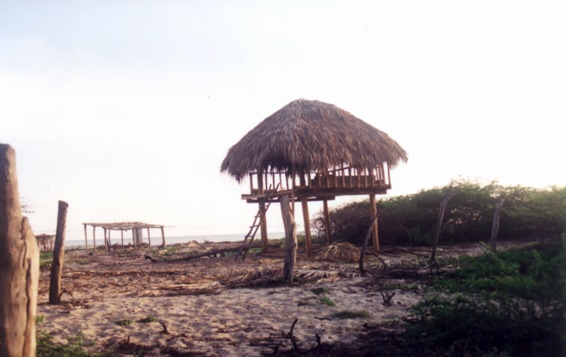 Galo pointed out the soleras, spots along the shore where the crocodiles like to warm themselves in
the afternoon sun. We disembarked at a rickety pier that leads to the short path to the beach.
Just above our heads, close enough to touch (but please don't), the intertwining branches held
dozens of ibis and cormorant nests, some with eggs, others containing chicks in various stages of
development. On the beach itself, the villagers have built an observation tower to view marine
turtles as they laboriously haul themselves over the beach lay their eggs.
Galo pointed out the soleras, spots along the shore where the crocodiles like to warm themselves in
the afternoon sun. We disembarked at a rickety pier that leads to the short path to the beach.
Just above our heads, close enough to touch (but please don't), the intertwining branches held
dozens of ibis and cormorant nests, some with eggs, others containing chicks in various stages of
development. On the beach itself, the villagers have built an observation tower to view marine
turtles as they laboriously haul themselves over the beach lay their eggs.
You should plan your visit for early evening or early morning to observe maximum animal activity. (Only mad dogs and tourists go in the noonday sun.) Unaccompanied tours are not permitted.
Tours cost 30 pesos per person. Night time tours are also offered, and full meal service and camping will soon be available.
Barra de Navidad is the "second" Barra, across the Colotepec River bridge on the coast highway towards Pochutla. Take the recently paved road into the center of town and continue about a block on the dirt road until you see the sign at the hatchery.
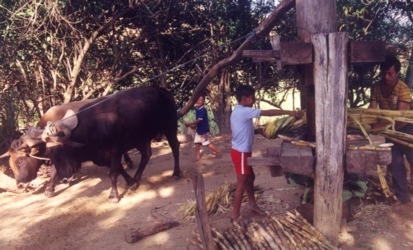
There will be parties with piñatas and toys for the kids throughout the nation.
One of the traditions of the season is the rosca de reyes, a round sweet egg bread that contains a small plastic doll.
This is meant to symbolize the hiding of the Christ child from King Herod's troops. According to the custom, whomever receives the piece of bread containing the doll is named godparent of the Christ child from the Nativity and must host a party on Candlemas (Candelaria), Feb. 2
Santos Reyes Nopala this picturesque town that throughout centuries has remained the important economic and cultural center for the Chatino Indians, celebrates its annual fair this month to honor the kings, who are its patron saints
Nopala is well worth visiting for its history, its cultural richness and the beauty of its landscape.
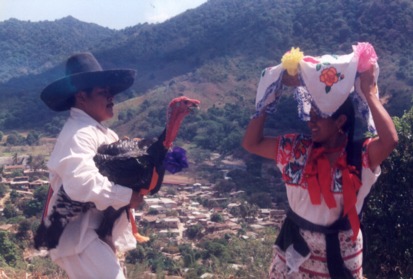 From as far back as 500 AD the town's Chatino rulers intermarried with Mixtec royalty.
From as far back as 500 AD the town's Chatino rulers intermarried with Mixtec royalty.
There are, in fact, several archeological remains in Santos Reyes Nopala which date from around 600 to 800 AD. These are mainly large stone carvings, dedicated to Chatino chiefs or priests, which can be seen in the walls of the municipal palace, the kiosk in the main plaza, as well as in some private homes.
Now an important coffee-growing area, it is interesting to visit Nopala's coffee plantations to observe the process from picking the coffee right through to packaging.
Nopala is also worth visiting if only to walk along its lovely paths and to marvel at the beauty of its streams, plains and surrounding mountains.
One of the most striking production processes for visitors to Nopala is the tradition of the trapiches, sugar cane juice is produced in wooden mills, powered by oxen. As in the past, tepache, a slightly bitter fermentation of the cane juice, imbibed at celebrations throughout the region, is produced here, as well as panela, a raw sugar that is a must on every Chatino table.
Another ancient production process can be seen at Santa Magdalena Tiltepec, a village just 20 minutes away from Nopala accessible by a dirt road. Here you can observe the women making all kinds of pots and clay figures entirely by hand, without the aid of a wheel.
Finally, if you can handle a two-hour walk up steep slopes, you'll find best view this side of paradise, at the waterfalls known as los Chorros de San Juan Lachao.
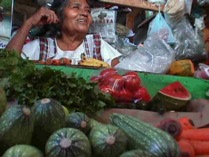 The original market in Puerto Escondido was located just off of Av. Oaxaca on First North Street,
at the plaza now known as Parque de Idilio. Sixteen years ago, the market was moved some 7 blocks
uptown, in what then seemed to be the huge Benito Juárez building.
The original market in Puerto Escondido was located just off of Av. Oaxaca on First North Street,
at the plaza now known as Parque de Idilio. Sixteen years ago, the market was moved some 7 blocks
uptown, in what then seemed to be the huge Benito Juárez building.
But as the town grew, the old market struggled to supply the needs of a rapidly expanding resident and visitor population. Now, after many years of planning and construction, the new Benito Juárez market, several times larger than its predecessor, is open for business.
These pages are your guide to Puerto's grand new market. Get to know it. Beyond its utilitarian function, it is a constant source of sensory delight and small surprises.


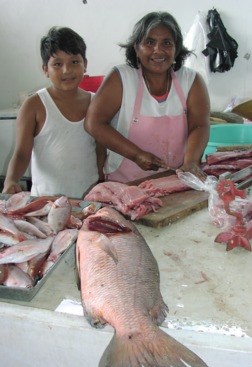
|
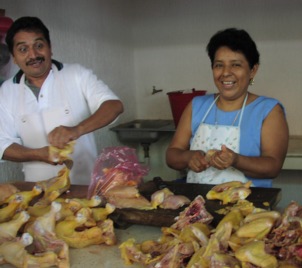
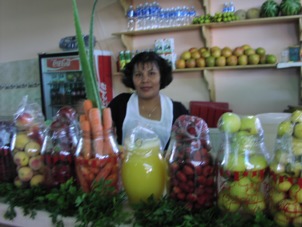
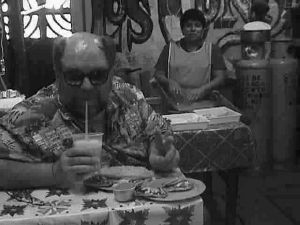
|
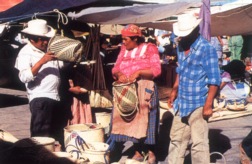
When most Europeans or North Americans think of shopping they tend to imagine large window displays on crowded city streets or huge shopping malls or mega-stores where you have little contact with the people who sell and those who sell have virtually no contact with those who produce and visa versa. Prices are set and we look for the perennial discount if we want a bargain.
In Latin America, and particularly in Oaxaca, shopping and the market place are cultures in themselves. Within the marketplace there is the merchant s internal subculture which is very complex, with a camaraderie of common interests and proximity stimulated by competition and sometimes not so friendly rivalry.
Add to that the shoppers culture of hunting for price and quality, bartering and socializing and you get the ever changing, dynamic mix that has been evolving for millennia.
The tourist, too, has a place in this culture and is expected to abide by certain rules. In general, the prices are somewhat higher for the tourist, but bartering is definitely allowed. One important rule is: Be sure to ask permission if you want to take photos, not because the people have some superstitious fear of having their picture taken, but because it s just common courtesy.
To the uninitiated, the Oaxacan marketplace can seem more hectic, exciting and confusing than the floor of the stock market. For this shopper one of the most exciting things about shopping here is just listening to the symphony of voices, dialects and languages and watching the unfolding kaleidoscope of images, colors and scenes.
No matter how many marketplaces you go to here, there is always something new to see, smell, hear, taste or learn.
If the immensity of the Abastos market is just too much for you, or you just want to get the feeling
of the smaller regional markets there are several within a short drive or bus ride from the city.
The closer to the city the wider the variety of products, but even within the Central Valleys there are regional differences in products and demographics. For example at the Sunday market of Tlacolula, you will find more mescal and woolen rugs from the surrounding towns and villages. At the Wednesday market in Etla there are more dairy products, the Tuesday Market in Ayoquesco de Aldama in the Valley of Zimatlán has a larger percentage of Indigenous as opposed to Mestizo merchants.
Some of the towns and villages near the city have little or no general market place but they are rightfully famous for their specific handcrafts or folk art. The most famous being some of the poorest because poor soil quality made it necessary for the inhabitants to find ways to supplement their incomes.
In the valley of Tlacolula you have regional clothing in Mitla, woolen rugs in Teotitlán and Santa Ana del Valle. In the Valley of Ocotlán you have clay figurines and fine embroidery in Ocotlán and San Antonino; and hand woven cotton belts and sashes in Santo Tomás Jalietza. Closer still to the city is San Bartolo Coyotepec with its famous black pottery, Atzompa with its terra-cotta and green glaze, and Arrazola is world famous for hand carved phantasmagorical wooden animals called "alebrijes". Each market has its special characteristics.
Oaxaca has a variety of options for you. Just remember: you are in a different culture, so try to be respectful and courteous and you will receive more than the same in return.
- - Pierre Spencer
| Puerto Escondido | Sat. & Wed |
| Santos Reyes Nopala | Sunday |
| Jamiltepec | Thur & Sun |
| Pinotepa Nacional | Sat. & Wed |
| Monday | Ixtlán: | Mountain birth place of Benito Juárez. |
| Tuesday | Ayoquezco: | Traditional Indigenous market, few tourists. |
| Wednesday | Etla: | Picturesque, good food, beautiful colonial church. |
| Thursday | Ejutla: | Indigenous people from all over the state. |
| Friday | Ocotlán: | Large regional market with people from all over, good food. |
| Saturday | Oaxaca: | Abastos market, you can find people and products from all over the state. |
| Sunday | Ayutla: | Picturesque Mixe and Zapotec mountainside town sometimes in the clouds. |
| Tlacolula: | Large regional market, many products and indigenous groups. |
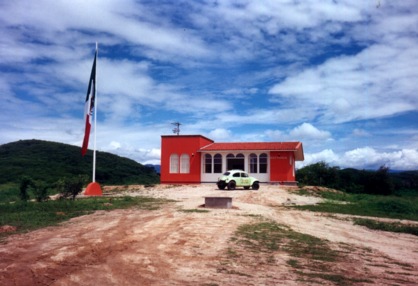 Besides the market and the tourist police, there are other major new developments in our town that
our regular Winter visitors might not be aware of. Last October, 40 young people from Puerto
Escondido began their higher education at the brand-new Puerto Escondido campus of the University of
the Sea (UMAR).
Besides the market and the tourist police, there are other major new developments in our town that
our regular Winter visitors might not be aware of. Last October, 40 young people from Puerto
Escondido began their higher education at the brand-new Puerto Escondido campus of the University of
the Sea (UMAR).
This is the third campus of UMAR, joining UMAR, Puerto Angel, which has a focus on oceanography and marine biology, and University of the Mixteca in Huajuapan de Leon, which specializes in technology. A fourth UMAR campus has opened in Huatulco, this one offering courses relating to tourism.
UMAR Puerto Escondido will focus on the earth sciences. This year's freshman class are working on degrees in biology, animal husbandry and forest management.
The UMAR campus, still a work in progress is located on the road out of town to San Pedro Mixtepec, past the gas plant.
 And just next door is Puerto's new Rodeo Arena, "Monumental Plaza de Toros La Costeñita".
This ample facility opened last month. It was a labor of love by the Carbajal brothers, best known
here as the amiable owners of Don Felix hardware store, where you are always welcome to serve
yourself a shot of mescal while you wait to be served.
And just next door is Puerto's new Rodeo Arena, "Monumental Plaza de Toros La Costeñita".
This ample facility opened last month. It was a labor of love by the Carbajal brothers, best known
here as the amiable owners of Don Felix hardware store, where you are always welcome to serve
yourself a shot of mescal while you wait to be served.
Less known is that the brothers Carbajal are great aficionados of the Jaripeo, the local version of rodeo. They also own the Rancho "Los 3 Gavilanes", which raises bulls for the sport.
And a reminder: In November all the telephone area codes in Mexico were changed. The new code for
Puerto Escondido is 954 in place of the old 9, which covered the entire state of Oaxaca. For
example, to call El Sol from the US or Canada, dial 011 52 954 582-2230.